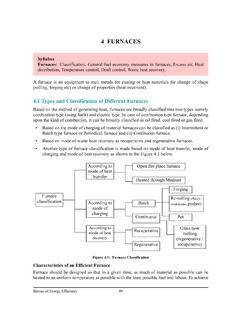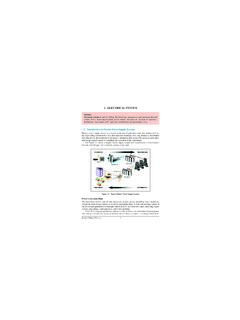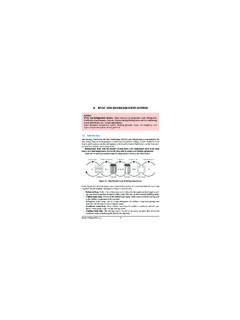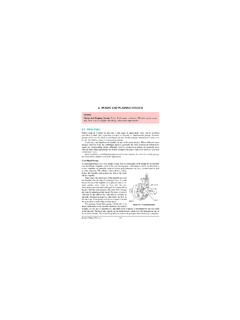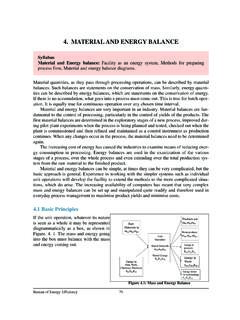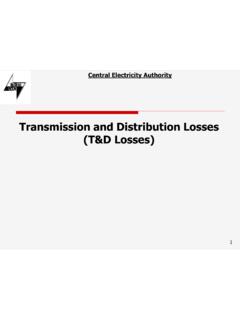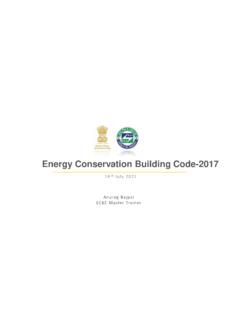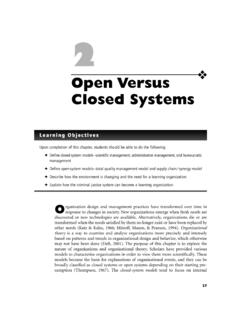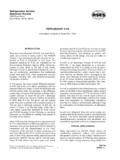Transcription of 3. COMPRESSED AIR SYSTEM - Bureau of Energy Efficiency
1 3. COMPRESSED AIR SYSTEM45 Bureau of Energy EfficiencySyllabus COMPRESSED air SYSTEM :Types of air compressors, Compressor Efficiency , Efficient com-pressor operation, COMPRESSED air SYSTEM components, Capacity assessment, Leakage test,Factors affecting the performance and IntroductionAir compressors account for significant amount of electricity used in Indian industries. Air com-pressors are used in a variety of industries to supply process requirements, to operate pneumatictools and equipment, and to meet instrumentation needs. Only 10 30% of Energy reaches the pointof end-use, and balance 70 90% of Energy of the power of the prime mover being converted tounusable heat Energy and to a lesser extent lost in form of friction, misuse and Compressor TypesCompressors are broadly classified as: Positive displacement compressor and displacement compressors increase the pressure of the gas by reducing the vol-ume. Positive displacement compressors are further classified as reciprocating and rotarycompressors.
2 Dynamic compressors increase the air velocity, which is then converted to increased pres-sure at the outlet. Dynamic compressors are basically centrifugal compressors and are furtherclassified as radial and axial flow flow and pressure requirements of a given application determine the suitability of a par-ticulars type of COMPRESSED Air System46 Bureau of Energy EfficiencyPositive Displacement CompressorsReciprocating CompressorsReciprocating compressors are the mostwidely used type for air are characterized by a flow outputthat remains nearly constant over a rangeof discharge pressures. Also, the com-pressor capacity is directly proportionalto the speed. The output, however, is apulsating compressors areavailable in many configurations, thefour most widely used of which arehorizontal, vertical, horizontal bal-ance-opposed and tandem. Verticaltype reciprocating compressors areused in the capacity range of 50 150cfm. Horizontal balance opposed compressors are used in the capacity range of 200 5000 cfmin multi-stage design and upto 10,000 cfm in single stage compressors are also available in variety of types: Lubricated and non-lubricated Single or multiple cylinder Water or air-cooled.
3 Single or multi stageIn the case of lubricated machines, oil has to be separated from the discharge air. Non-lubri-cated compressors are especially useful for providing air for instrumentation and for processeswhich require oil free discharge. However non-lubricated machines have higher specific powerconsumption (kW/cfm) as compared to lubricated cylinder machines are generally air-cooled, while multi-cylinder machines are gen-erally water cooled, although multi-stage air-cooled types are available for machines up to 100kW. Water-cooled systems are more Energy efficient than air-cooled stage machines are used for high pressures and are characterized by lower discharge temper-ature (140 to 160 C) compared to single-stage machines (205 to 240 C). In some cases, multi-stagemachines may have a lower specific power consumption compared to single stage machines operatingover the same total pressure differential. Multi-stage machines generally have higher investment costs,particularly for applications with high discharge pressure (above 7 bar) and low capacities (less than 25cfm).
4 Multi staging has other benefits, such as reduced pressure differential across cylinders, whichreduces the load and stress on compressor components such as valves and piston CompressorsRotary compressors have rotors in place of pistons and give a continuous, pulsation free discharge are directly coupled to the prime mover and require lower starting torque as compared to recip-rocating machine. They operate at high speed and generally provide higher throughput than recipro-cating compressors. Also they require smaller foundations,vibrate less, and have a lower number of parts - which means lessfailure rotary compressor, the Roots blower (alsocalled as lobe compressor) and screw compressors areamong the most widely used. The roots blower is essen-tially a low-pressure blower and is limited to a dischargepressure of 1 bar in single-stage design and up to barin two stage most common rotary air compressor is the singlestage helical or spiral lube oil flooded screw air compressors consist of two rotors, within a casingwhere the rotors compress the air internally.
5 There are novalves. These units are basically oil cooled (with air cooledor water cooled oil coolers) where the oil seals the internal clearances. Since the cooling takesplace right inside the compressor, the working parts never experience extreme operating tem-peratures. The oil has to be separated from discharge air. Because of the simple design and fewwearing parts, rotary screw air compressors are easy to maintain, to operate and oil free rotary screw air compressor uses specially designed air ends to compress air withoutoil in the compression chamber producing true oil free air. These compressors are available as air-cooled or water cooled types and provide the same flexibility as oil flooded rotary is a wide range of availability in configuration and in pressure and capacity. Dry typesdeliver oil-free air and are available in sizes up to 20,000 cfm and pressure upto 15 bar. Lubricatedtypes are available in sizes ranging from 100 to 1000 cfm, with discharge pressure up to 10 bar.
6 3. COMPRESSED Air System47 Bureau of Energy EfficiencyDynamic CompressorsDynamic compressors are mainly centrifugalcompressors and operate on similar principlesto centrifugal pump. These compressors haveappreciably different characteristics as com-pared to reciprocating machines. A smallchange in compression ratio produces amarked change in compressor output and effi- ciency . Centrifugal machines are better suitedfor applications requiring very high capacities,typically above 12,000 centrifugal air compressor depends ontransfer of Energy from a rotating impeller tothe air. The rotor accomplishes this by chang-ing the momentum and pressure of the air. Thismomentum is converted to useful pressure byslowing the air down in a stationary centrifugal air compressor is an oil free compressor by design. The oil-lubricated run-ning gear is separated from the air by shaft seals and atmospheric vents. The centrifugal is acontinuous duty compressor, with few moving parts, and is particularly suited to high volumeapplications, especially where oil free air is single-stage centrifugal machine can provide the same capacity as a multi-stage rec-iprocating compressor.
7 Machines with either axial or radial flow impellers are available. Axial flow compressors are suitable for higher compression ratios and are generally moreefficient than radial compressors. Axial compressors typically are multi-stage machines, whileradial machines are usually single-stage general selection criteria for compressor is given in the Table COMPRESSED Air System48 Bureau of Energy EfficiencyTABLE GENERAL SELECTION CRITERIA FOR COMPRESSORSType of CompressorCapacity (m3/h)Pressure (bar)FromToFromToRoots blower compressorsingle Single / Two Multi Single Two Axial Compressor PerformanceCapacity of a CompressorCapacity of a compressor is the full rated volume of flow of gas COMPRESSED and delivered atconditions of total temperature, total pressure, and composition prevailing at the compressorinlet. It sometimes means actual flow rate, rather than rated volume of flow. This also termedas Free Air Delivery (FAD) air at atmospheric conditions at any specific location.
8 Becausethe altitude, barometer, and temperature may vary at different localities and at different times,it follows that this term does not mean air under identical or standard Efficiency DefinitionsSeveral different measures of compressor Efficiency are commonly used: volumetric Efficiency ,adiabatic Efficiency , isothermal Efficiency and and isothermal efficiencies are computed as the isothermal or adiabatic powerdivided by the actual power consumption. The figure obtained indicates the overall efficiencyof compressor and drive Efficiency3. COMPRESSED Air System49 Bureau of Energy EfficiencyIsothermal power(kW)=P1x Q1x P1=Absolute intake pressure kg/ cm2P2=Absolute delivery pressure kg/ cm2Q1=Free air delivered m3 ratio P2/P1 The calculation of isothermal power does not include power needed to overcome frictionand generally gives an Efficiency that is lower than adiabatic Efficiency . The reported value ofefficiency is normally the isothermal Efficiency .
9 This is an important consideration when select-ing compressors based on reported values of Efficiency .(x 100)()Volumetric EfficiencyCompressor Displacement= x D2x L x S x x n4D=Cylinder bore, metreL=Cylinder stroke, metreS=Compressor speed rpm =1 for single acting and2 for double acting cylindersn=No. of cylindersFor practical purposes, the most effective guide in comparing compressor efficiencies is thespecific power consumption ie kW/volume flow rate , for different compressors that would pro-vide identical COMPRESSED Air SYSTEM ComponentsCompressed air systems consist of following major components: Intake air filters, inter-stagecoolers, after coolers, air dryers, moisture drain traps, receivers, piping network, filters, regula-tors and lubricators (see Figure ). Intake Air Filters: Prevent dust from entering compressor; Dust causes sticking valves,scoured cylinders, excessive wear etc. Inter-stage Coolers: Reduce the temperature of the air before it enters the next stage toreduce the work of compression and increase Efficiency .
10 They are normally water-cooled. After Coolers: The objective is to remove the moisture in the air by reducing the tempera-ture in a water-cooled heat exchanger. Air-dryers: The remaining traces of moisture after after-cooler are removed using air dry-ers, as air for instrument and pneumatic equipment has to be relatively free of any moisture is removed by using adsorbents like silica gel /activated carbon, or refrigerantdryers, or heat of compression dryers. Moisture Drain Traps: Moisture drain traps are used for removal of moisture in the com-pressed air. These traps resemble steam traps. Various types of traps used are manual draincocks, timer based / automatic drain valves etc. Receivers: Air receivers are provided as storage and smoothening pulsating air output -reducing pressure variations from the compressor 3. COMPRESSED Air System50 Bureau of Energy Efficient Operation of COMPRESSED Air SystemsLocation of CompressorsThe location of air compressors and the quality of air drawn by the compressors will have a sig-nificant influence on the amount of Energy consumed.
